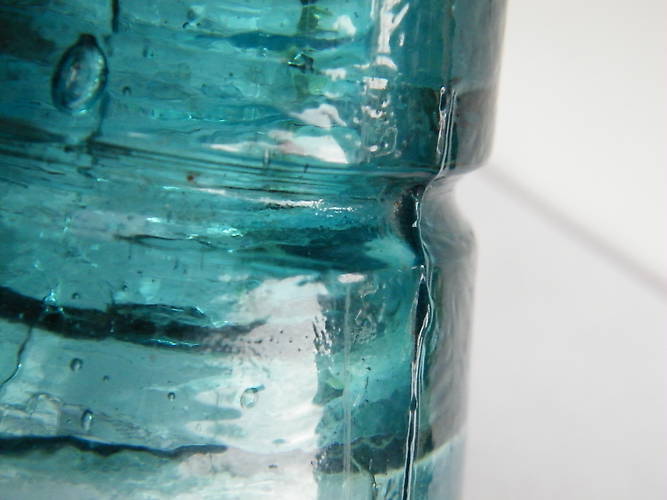
My thanks to all Icon members for their responses to my questions. I've added the most informative emails to this post. Scroll down the page to see those answers. Thanks again! As can be seen well in my pic the mold line extends up at least 1/4" above the wire groove on this particular American EIN 020 beehive on both sides, I've noticed on any other insulators regardless of the CD# the mold line stops inside the wire groove. There is also a noticible step that goes completely around the dome where those mold lines end. I've had this insulator and that detail has been bugging me for some time with a number of questions to ask. First question is, how common is this extended mold lines when it comes to American beehives? More questions below: Question #2 : Was the American Insulator Company the first company to produce a beehive insulator? If this is so it would explain some developemental history of all beehive insulators made later by all beehive makers. Question #3 : If that extended mold line isn't present on most American beehives would this insulator be considered to have been made in a sort of transition mold? Later the molds would have been modified so that the mold line ended inside the wire groove so the step would no longer be present? Question #4 If question #3 above is true should this insulator be assigned a seperate EIN? Bill Snell : Hi Roger, Not sure if you posted anything to ICON (I get the digest, so if you did, I'll see it tomorrow and share a reply with everyone) but I saw your photo and questions in the photo gallery. Good questions! This is probably more detail about American beehives than you'll ever want to know... Over the years I've identified ten American CD 145 beehive molds with various embossing differences, mold letters and dome shapes. The mold top letters I've been able to find are I, V and XI (or IX, depending on how you look at it). There's also the [010] "Insolator" embossing error variant, which has no top number at all. The V mold is the large, wide groove style that only comes embossed with two dates. That moldline is at the very top of the wire groove, similar to the "normal" HG Co and later skirt-embossed Brookfield beehives. The I molds have two and three date versions, and XI molds only come with three dates, either the Jan. 29 error or the correct Feb. 12 date. All I and XI molds I've seen have the mold line you noted, about a quarter-inch above the wire groove. The "no number" American with the "Insolator" embossing error has the moldline just about a quarter inch above the wire groove, almost forming a little ridge. Your question 2 – since Samuel Oakman received the design patent for the beehive style and American was (more or less) his company, I think American was at least among the first beehive makers, and I feel the "Insolator" variant was probably the first attempt as the company tried to manufacture it reliably. All of the "Insolator" examples I've seen tend to slump and it looks like the glass makers had some trouble getting it to come out right. The crown embossed Brookfield beehives with only the 1870 date might be a candidate for first beehive, too, but it's tough to know for certain. I believe – but I have no proof or even a way to verify – that Oakman attempted to get a letters patent for the beehive a year or two before, but the patent office rejected the claim so he tried again with a design patent and received approval. Question 3 – this moldline feature is fairly common on American beehives. At the same time, Brookfield was still using two-piece molds and their beehives have MLOD. Hemingray's moldline was at the wire groove. Not sure we can conclude there was a true transition or if it was just different mold making shops preferring to do things different ways. You got me curious, so I went to my shelf and looked at other American shapes. Most of them have the moldline just above the wire groove. The one exception I saw was the two-date CD 156.1, which has a mold line about 1/8 inch above the upper ridge. The CD 144.5 embossed with only PAT'D AUG. 19, 1890 (another Oakman patent, and most likely a product of Oakman Mfg. Co., much later than the American beehives) also has a moldline about ¼ inch above the wire groove. So it looks like the mold makers working with Samuel Oakman seemed to have a tendency to do that with three-piece molds. Question 4 – I don't know how Don determines what's a different EIN so maybe he'll have an answer. Dan Gay : Hello Roger Interesting observation. Of the 7 American beehive's I own, 4 have the extended mold line you describe. Also noted is that all 4 are the more rounded dome variant [or flatter top] One is yellow olive green, one is yellow green, one is that beautiful "American" blue and one is blue aqua. The more pointed top or taller beehives have the mold line with in the wire groove. I hope that helps. Dan Gay NIA # 3715 |